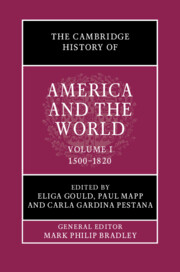Book contents
- The Cambridge History of America and the World
- The Cambridge History of America and the World
- The Cambridge History of America and the World
- Copyright page
- Contents
- Figures
- Maps
- Contributors to Volume I
- General Introduction: What is America and the World?
- Introduction: What Does America and the World “Mean” before 1825?
- Part I Geographies
- Part II People
- Part III Empires
- Part IV Circulation/Connections
- Part V Institutions
- Part VI Revolutions
- 22 Independence and Union: Imperfect Unions in Revolutionary Anglo-America
- 23 Atlantic Revolutions
- 24 Citizenship
- 25 The United States and the Americas
- Index
22 - Independence and Union: Imperfect Unions in Revolutionary Anglo-America
from Part VI - Revolutions
Published online by Cambridge University Press: 12 November 2021
- The Cambridge History of America and the World
- The Cambridge History of America and the World
- The Cambridge History of America and the World
- Copyright page
- Contents
- Figures
- Maps
- Contributors to Volume I
- General Introduction: What is America and the World?
- Introduction: What Does America and the World “Mean” before 1825?
- Part I Geographies
- Part II People
- Part III Empires
- Part IV Circulation/Connections
- Part V Institutions
- Part VI Revolutions
- 22 Independence and Union: Imperfect Unions in Revolutionary Anglo-America
- 23 Atlantic Revolutions
- 24 Citizenship
- 25 The United States and the Americas
- Index
Summary
Independence or union? Alone or connected? In revolutionary America, this was a false choice. Most defined the choice of revolution – the choice for the North American provinces, and for themselves – as between remaining in one complex polity and creating another. The choice was between competing unions. But there had always been more than one union in the colonists’ Atlantic world, and, after independence, the possibilities for association proliferated. The Age of Revolutions witnessed an astounding array of imaginative plans for integrating peoples, places, and ideas. Only in retrospect does the reciprocity between independence and union seem paradoxical. Many still remember that the Declaration of Independence “dissolve[d]” the “political connections” to Great Britain, but not Congress’s simultaneous assumption of the power to “contract alliances, establish commerce, and to do all other acts and things which independent states may of right do.” Although Patrick Henry’s demand for “liberty or death” may have rallied some to the cause, Benjamin Franklin’s repeated injunction to “join, or die” better captured revolutionary imperatives.
- Type
- Chapter
- Information
- The Cambridge History of America and the World , pp. 487 - 509Publisher: Cambridge University PressPrint publication year: 2022

